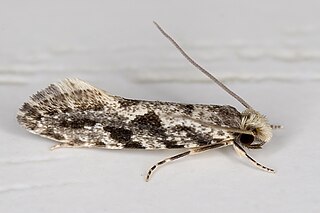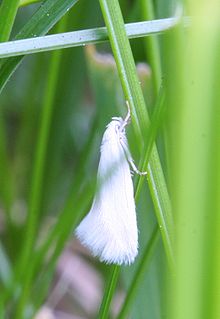
The Batrachedridae are a small family of tiny moths. These are small, slender moths which rest with their wings wrapped tightly around their bodies.

Pterolonchidae is a small family of very small moths in the superfamily Gelechioidea. There are species native to every continent except Australia and Antarctica.

The white-shouldered house moth is a species of gelechioid moth. It belongs to the subfamily Oecophorinae of the concealer moth family (Oecophoridae), just like the brown house moth. Though several presumed congeners of E. sarcitrella were described, its genus Endrosis is currently understood to be monotypic.

Acompsia is a genus of the twirler moth family (Gelechiidae). Though it has once been assigned to the proposed subfamily "Anacampsinae", it is generally placed in the Dichomeridinae. Some authors include Telephila here as a subgenus, while others prefer to keep it distinct as its relationships are fairly obscure.

Brachmia is a genus of the twirler moth family (Gelechiidae). Among these, it is mostly placed in the subfamily Dichomeridinae.
Ephysteris is a genus of the twirler moth family (Gelechiidae). Among these, it is assigned to tribe Gnorimoschemini of the subfamily Gelechiinae. Even though it is a rather diverse and widespread group, most of these small and inconspicuous moths were overlooked by scientists until the early 20th century. Almost 90 species are known today, but new ones are still being discovered.

Hypatima is a genus of the twirler moth family (Gelechiidae). Among these, it belongs to a distinct lineage, which is variously treated as tribe Chelariini in subfamilies Dichomeridinae, Gelechiinae, or even Pexicopiinae, and historically was considered a subfamily in its own right, Chelariinae. Of this lineage, Hypatima – under its junior synonym Chelaria – is the type genus. This genus has numerous species, but its exact limits are not quite clear. This genus occurs mainly in the Southern Hemisphere, though one of the better-known species is the only member of this genus native to Europe, the lobster-clawed moth.

Imma is a large genus of moths in the obtectomeran "micromoth" family Immidae. This is the type genus of its family. They are widespread in the tropics, with most species occurring between the Himalayas and the Oceanian region; the genus is furthermore plentiful in the Neotropics, but not very diverse in the Afrotropics.

Nemapogon granella is a species of tineoid moth. It belongs to the fungus moth family (Tineidae), and therein to the subfamily Nemapogoninae. It is the type species of its genus Nemapogon, and via that also of the subfamily Nemapogoninae. It is also the type species of the proposed genera Brosis and Diaphthirusa, which are consequently junior objective synonyms of Nemapogon.

Ectropis is a genus in the geometer moth family (Geometridae). They are mostly paleotropical, but also plentiful in Australia and extend into Asia. Only one species – or cryptic species complex – is found in Europe. There are about 100 known species in this genus.

Erechthias is a genus of the fungus moth family, Tineidae. Therein, it belongs to the subfamily Erechthiinae, of which it is the type genus. The exact circumscription of this genus is still disputed, but it may encompass more than 150 species.

Nemapogon is a genus of the fungus moth family, Tineidae. Therein, it belongs to the subfamily Nemapogoninae. As evident by its name, it is the type genus of its subfamily.

Monopis is a genus of the fungus moth family, Tineidae. Therein, it belongs to the nominate subfamily, Tineinae.

The Depressariinae – sometimes spelled "Depressiinae" in error – are a subfamily of moths in the superfamily Gelechioidea. Like their relatives therein, their exact relationships are not yet very well resolved. It has been considered part of family Elachistidae sensu lato or included in an expanded Oecophoridae. In modern classifications they are treated as the distinct gelechioid family Depressariidae.

Scythris is a genus of gelechioid moths. It is the type genus of the flower moth family, which is sometimes included as a subfamily in the Xyloryctidae, or together with these merged into the Oecophoridae. The genus was erected by Jacob Hübner in 1825.

Tinea is a genus of the fungus moth family, Tineidae. Therein, it belongs to the subfamily Tineinae. As evident by its name, it is the type genus of its subfamily and family. Established as one of the first subgroups of "Phalaena", it used to contain many species of Tineidae that are nowadays placed in other genera, as well as a few moths nowadays placed elsewhere.

Elachista is a genus of gelechioid moths described by Georg Friedrich Treitschke in 1833. It is the type genus of the grass-miner moth family (Elachistidae). This family is sometimes circumscribed very loosely, including for example the Agonoxenidae and Ethmiidae which seem to be quite distinct among the Gelechioidea, as well as other lineages which are widely held to be closer to Oecophora than to Elachista and are thus placed in the concealer moth family Oecophoridae here.

Autosticha is a genus of gelechioid moths. It belongs to the subfamily Autostichinae, which is either placed in the concealer moth family (Oecophoridae), or in an expanded Autostichidae. It is the type genus of its subfamily. Originally, this genus was named Automola, but this name properly refers to a fly genus in family Richardiidae.

Gracillariinae are a subfamily of moths which was described by Henry Tibbats Stainton in 1854.
Heosphora is a genus of moths in the family Pyralidae. The genus was first described by Edward Meyrick in 1882. The type species is Anerastia psamathella Meyrick, 1879, designated as such by George Hampson in 1901. All Heosphora species are found in Australia.
















